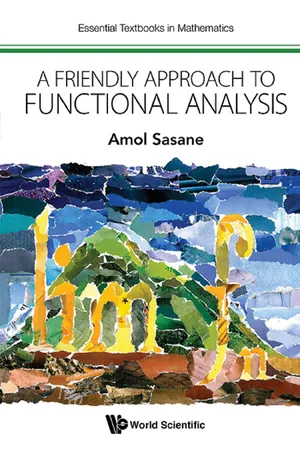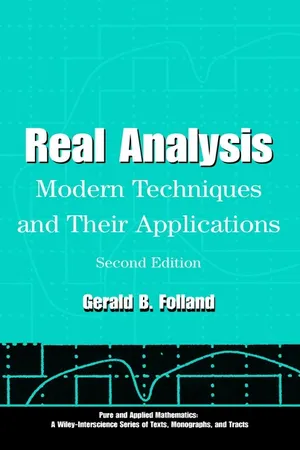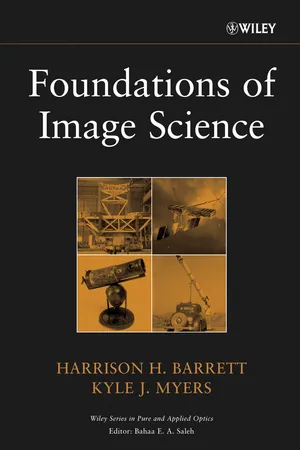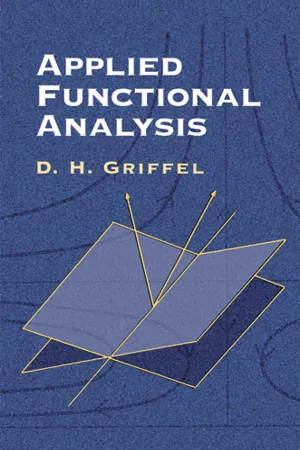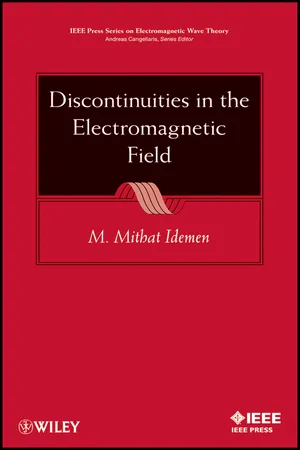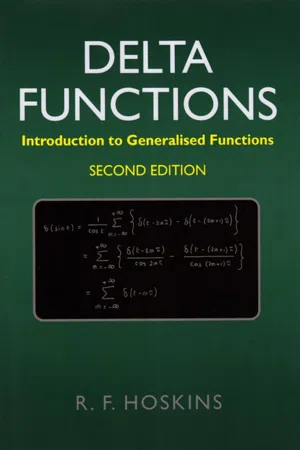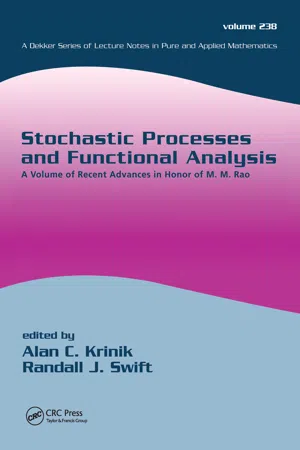Mathematics
Distributions
In mathematics, distributions refer to a generalization of functions that can act on test functions to produce real numbers. They are used to extend the concept of derivatives to a wider class of functions, including those that are not necessarily smooth or continuous. Distributions are fundamental in the study of partial differential equations and functional analysis.
Written by Perlego with AI-assistance
Related key terms
Related key terms
1 of 4
Related key terms
1 of 3
8 Key excerpts on "Distributions"
- eBook - ePub
- Amol Sasane(Author)
- 2017(Publication Date)
- WSPC (EUROPE)(Publisher)
Chapter 6
A glimpse of distribution theory
In this last chapter of the book, we will see a generalisation of functionsand their ordinary calculus to “Distributions” or “generalised functions”. These Distributions will be “continuous linear functionals on the vector space of test functions D (RWhy study Distributions? We list three main reasons:d)”:(1)To mathematically model the situation when one has an impulsive force (imagine a blow to an object which changes its momentum, but the force itself is supposed to act “impulsively”, that is the time interval when the force is applied is 0!). Similar situations arise in other instances in mathematics and the applied sciences.(2)To develop a calculus which captures more general situations than the classical case. For example, what is the derivative of |x| at x = 0? It will turn out that this is also useful to talk about weaker notions of solutions of Partial Differential Equations (PDEs).(3)To extend the Fourier transform theory to functions that may not be absolutely integrable. For example, what1 is the Fourier transform of the constant function 1?It turns out that the theory of Distributions solves all of these three problems in one go. This seems like a miracle, and naturally there is a price to pay. The price is that everything classical is now replaced by a weaker notion. Nevertheless this is useful, since it is often sufficient for what one wants to do. An example is that, as opposed to functions on R , which have a well-defined value at every point x ∈ R , we can no longer talk about the value of a distribution at a point of R .Let us elaborate on reason (2) above, in the context of PDEs. An example we met earlier in Exercise 3.17, page 143, is that of the wave equation (which describes the motion of a plucked guitar string), and we had checked that for a twice continuously differentiable fgives a solution with the initial condition described by f (and zero initial velocity). However, when we pluck a guitar string, the initial shape needn’t be C2 - eBook - ePub
Real Analysis
Modern Techniques and Their Applications
- Gerald B. Folland(Author)
- 2013(Publication Date)
- Wiley(Publisher)
Chapter 9Elements of Distribution Theory
At least as far back as Heaviside in the 1890s, engineers and physicists have found it convenient to consider mathematical objects which, roughly speaking, resemble functions but are more singular than functions. Despite their evident efficacy, such objects were at first received with disdain and perplexity by the pure mathematicians, and one of the most important conceptual advances in modern analysis is the development of methods for dealing with them in a rigorous and systematic way. The method that has proved to be most generally useful is Laurent Schwartz’s theory of Distributions, based on the idea of linear functionals on test functions. For some purposes, however, it is preferable to use a theory more closely tied to L2 on which the power of Hilbert space methods and the Plancherel theorem can be brought to bear, namely, the (L2 ) Sobolev spaces. In this chapter we present the fundamentals of these theories and some of their applications.9.1 Distributions
In order to find a fruitful generalization of the notion of function onn, it is necessary to get away from the classical definition of function as a map that assigns to each point ofna numerical value. We have already done this to some extent in the theory of Lpspaces: If f Lp, the pointwise values f(x) are of little significance for the behavior of f as an element of Lp, as f can be modified on any set of measure zero without affecting the latter. What is more to the point is the family of integrals ∫ fϕ as ϕ ranges over the dual space Lq. Indeed, we know that f is completely determined by its action as a linear functional on Lq; on the other hand, if we take ϕ = ϕr= m(Br)−1 χBrwhere Bris the ball of radius r about x, by the Lebesgue differentiation theorem we can recover the pointwise value f(x), for almost every x, as limr→0∫ fϕr. Thus, we lose nothing by thinking of f as a linear map from Lq(n) to rather than as a map fromnto - eBook - ePub
- Harrison H. Barrett, Kyle J. Myers(Authors)
- 2013(Publication Date)
- Wiley-Interscience(Publisher)
theory of Distributions, originally developed by Laurent Schwartz (1950). We give a brief summary of this theory in the next section, but then make use of all three approaches to delta functions in what follows. The hope is that this strategy will allow delta functions to be understood at several different levels of rigor. The reader who is content with a less rigorous development can jump to Sec. 2.2 without loss of continuity.2.1 THEORY OF Distributions
2.1.1 Basic concepts
In brief, a distribution is a linear, continuous functional that maps a function t(x) to a real or complex number. For simplicity, we assume initially that t(x) is a real, scalar-valued function of a single real variable x. We have seen in Chap. 1 that the general form of a bounded, continuous, linear functional on a Hilbert space is given by the Riesz representation theorem, (1.24) , as(2.1)where g(x), known as the kernel of the functional, must lie in the Hilbert space (Gohberg and Goldberg, 1981, p. 61). If the Hilbert space is 2 , g(x) must be square-integrable.If we give up on the requirement that the kernel lie in a Hilbert space, we can define a wider class of functional known as Distributions. When we do so, we shall always write the distribution in the Riesz form, like (2.1) , but then g(x) need not be a square-integrable function or even a function at all in the conventional sense. All we have to do is specify the mapping rule of the functional, and that, in turn, will give meaning to the kernel function, which we then term a generalized function.As a simple example, consider the function g(x) = 1/x. We might be tempted to define a functional using this kernel as(2.2)but this integral is not well defined (unless t(0) = 0) because of the singularity at x - eBook - ePub
- D.H. Griffel(Author)
- 2012(Publication Date)
- Dover Publications(Publisher)
Thus the class of Distributions contains objects which correspond to ordinary functions as well as singular Distributions which do not. In the next section we shall define operations on Distributions analogous to the operations of ordinary algebra and calculus applied to functions. This will justify calling Distributions ‘generalised functions’, and will allow us to use Distributions for most of the purposes for which ordinary functions are used.1.3 Operations on Distributions
Definition 1.16 (Addition) If ƒ and g are Distributions and a and b are complex numbers, we define the distribution aƒ + bg to be the functional φ a 〈ƒ ,φ 〉 + b 〈g ,φ 〉 for all φ in .Strictly speaking we should verify that this defines a linear continuous functional on , but that is very easy and is left to the reader. The same applies to other definitions in this section.Definition 1.17 (Multiplication) If ƒ is a distribution and h is a smooth function (cf. Definition 1.2), we define the product of ƒ and h to be the distribution hƒ : φ 〈ƒ ,h φ 〉 for all φ in .Note that if φ is a test function and h is smooth, then h φ is a test function, and therefore 〈ƒ ,h φ 〉 is well-defined. If h is not smooth, then neither is h φ , hence h , and Definition 1.17 does not work. Thus we cannot define the product of a distribution with a function which is discontinuous or has a discontinuous derivative. Distributions cannot in general be multiplied. The difficulty can be seen in the followingExample 1.18 The Heaviside function H is defined byand an almost identical function H 1 is defined byH and H 1 are locally integrable, and they generate the same regular distribution . There is no distinction between H 1 and H in generalised function theory, and this reflects the fact that from the point of view of the physicist the distinction between them is artificial: one could never distinguish between H 1 and H experimentally. If Definition 1.17 were extended to discontinuous functions, we would have 〈H 1 δ ,φ 〉 = 0, Now, any definition of the product of two Distributions would have to agree with Definition 1.17 in the case that one of the Distributions was regular. Since H 1 and H generate the same distributionH ,we would have two different values for 〈H δ,φ 〉, and thus an inconsistent theory. This shows that it is impossible to define the product of δ - eBook - ePub
- M. Mithat Idemen(Author)
- 2011(Publication Date)
- Wiley-IEEE Press(Publisher)
Chapter 2 Distributions and Derivatives in the Sense of Distribution 2.1 Functions and DistributionsEven in the early days of the second half of the nineteenth century, one had observed that the mathematics, especially the concepts of functions and derivatives which had been established and maturated during the eighteenth and nineteenth centuries and permitted us to investigate various natural phenomena with deep insight, is not sufficient to grasp certain singularities in natural phenomena. To overcome the difficulties, one tried, from time to time, to introduce some concepts and to derive some formulas that were not based on solid mathematical basis. For example, Gustav Robert Kirchhoff,* a famous German physicist of the nineteenth century, had tried to define a force that acts on a very small area as follows [6]:2.1For the same purpose Paul Dirac,† a very celebrated English physicist of the last century, had introduced his famous function‡ δ(x ), which had the following properties [7]:2.2a2.2bsuch that2.2cBy using this exotic δ-function , Dirac had obtained some results that were adopted by physicists with enthusiasm. But the mathematicians of those days were watching the progress with certain reserve because they had known that the requirements stipulated by (2.2a)–(2.2c) were not compatible with the classical definitions of function and integral (in the Lebesgue sense).Although it did not exist as a function in the proper sense of function, in the first half of the last century δ(x ) was extensively used with its properties given in (2.2a–c) by physicists and engineers to produce many interesting results that could all be interpreted in an acceptable manner. This achievement encouraged mathematicians of that time to establish a rigorous basis for the exotic δ(x ), which, from one perspective will ensure its adoption by mathematicians without any reserve and, from the other perspective, will permit one to interpret correctly the results obtained through it. This goal was achieved by the famous French mathematician Laurent Schwartz* in 1950 [8]. The result was the introduction of some new entities and concepts into the mathematics of the twentieth century. These new entities are the so-called generalized functions , which involve also all locally integrable functions. Considering previous uses of δ(x ) to represent charge Distributions, localized on point sets or lines or surfaces, these new entities were also referred to as the distribution functions or, more simply, Distributions . In this monograph we will follow the founder of the theory and use this name—that is, distribution - eBook - ePub
Delta Functions
Introduction to Generalised Functions
- R F Hoskins(Author)
- 2009(Publication Date)
- Woodhead Publishing(Publisher)
As a result we have only been able to define a restricted sub-class of the generalised functions introduced by Laurent Schwartz and called by him Distributions. We have only discussed what are properly described as Distributions of finite order. Thus, to begin with, we dealt with regular Distributions (those defined by ordinary functions and integration processes) and delta functions: these were all identified as linear functionals which are relatively bounded on D with respect to the uniform norm || f ||, and they are accordingly referred to as Distributions of order 0. Next we have Distributions like the first derivative δ ′ of the delta function, which are linear functionals relatively bounded on D with respect to the norm || f || (1), and not with respect to the uniform norm || f || itself: these are similarly described as Distributions of order 1. And so on, with Distributions of order p, where p ∈, being defined as just those linear functionals which are relatively bounded on D with respect to the norm || f || (p), and not with respect to any norm ||| f || (q) where q < p. This restriction is not of any immediate major importance: Distributions of finite order are generally the most widely applicable and in practice will be found to suffice for most practical purposes. But for completeness we need to give here some account of the full scope of the Schwartz theory, as well as of its limitations and of some of the subsequent modifications and extensions of the theory which have been proposed. 8.4.2 Schwartz Distributions Consider first the problem of defining general Schwartz Distributions - that is, to define the class of all continuous linear functionals on D, including “Distributions of infinite order”. Briefly, suppose we take the norm || f || (p) defined by equation (8.5), and the corresponding concept of p -convergence, and then allow p to tend to infinity - eBook - ePub
Stochastic Processes and Functional Analysis
A Volume of Recent Advances in Honor of M. M. Rao
- Alan C. Krinik, Randall J. Swift(Authors)
- 2004(Publication Date)
- CRC Press(Publisher)
It is necessary to remark that although real hypernumbers look similar to hyperreal numbers of nonstandard analysis [17], they are different and have rather dissimilar properties. The cause for this is that hyperreal numbers from nonstandard analysis are built based on set theoretical constructions [18, 19], while real hypernumbers are built based on topological constructions (cf., Section 2.3).In the fourth section of this paper, extended Distributions are introduced and studied. The aim is to extend the domain where mathematician and physicist can look for solutions for differential equations. To solve their equations, physicists have often used structures that were outlawed in mathematics of their time. Mathematicians, to increase the power of their methods and to catch up with physicists, have always generalized mathematical structures. Along this avenue, Sobolev introduced the, so called, generalized solutions of differential equations and Schwartz introduced Distributions. However, Distributions do not solve all problems that arise in mathematics and physics. As a result, some generalizations of Distributions were introduced.In recent years in the works by Li Bang-He and Li Ya-Qing [13], Fisher [20 - 22], Rosinger [23, 24], Colombeau [25-28], Oberguggenberger [29, 30], Burgin [31, 32], Egorov [10 - 12], Delcroix and Scarpalezos [33] and others, a new theory of generalized functions is developed. However, this development of distribution theory has been aimed at elaborating algebraic structures on the sets of Distributions. Consequently, the possibilities of these theories are either included in theory of extrafunctions or they involve such weak topology that does not satisfy even the weakest separation axiom T0. For example, theory of generalized function, which is developed by Egorov [10-12] and is the most general in comparison with other extensions of distribution theory, allows getting solutions to a very vast class of differential equations. Theory of extrafunctions makes possible to obtain solutions to the same classes of equations but in a Hausdorff space, which has a much better topology. At the same time, in topology of the generalized functions from [10-12] a sequences may have several different limits. - eBook - ePub
- Robert M. Bethea(Author)
- 2018(Publication Date)
- CRC Press(Publisher)
3Distributions
3.1 Introduction
Most statistical methods useful to engineers and scientists deal with the collection, organization, analysis, and presentation of data. Such analyses of experimental data are used in making reasonable decisions that are based at least partly on the data.Application of the methods of statistics requires an understanding of data and its characteristics, the most common of which are average and variation. These characteristics are reflected by Distributions, either experimental (empirical) or theoretical. Most statistical methods are based on theoretical Distributions that approximate the actual Distributions. Thus the user of statistical methods must be familiar not only with the theoretical Distributions but also with the distribution characteristics of the population(s) under consideration.3.2 Definitions
Certain terms relative to Distributions have special meanings in statistical usage. The most common of these terms are:- Population: a collection of objects that have at least one characteristic (attribute) in common Sample: a subset of a population
- Observation: a recording of information on some characteristic of an object
- Measurement: a numerical value indicating the extent, intensity, or size of a characteristic of an object
- Sample space: the set of all possible outcomes of an experiment, that is, all possible results of a process that generates data
- Random variable: a function from a sample space to the real line, that is, a function that assigns a real value to each outcome in a sample space
- Discrete variable: a variable that can assume only isolated values, that is, values in a finite or countably infinite set Continuous variable: a variable that can assume any value between two distinct numbers
- Cumulative frequency: the sum of the frequencies of all values less than or equal to a particular value
All of these terms will be used in the ensuing sections, where their meanings will become increasingly clearer to the reader. However, since the terms population and sample are quite often confused with each other, a word of clarification is in line here. A population can be considered to be the set of all
Index pages curate the most relevant extracts from our library of academic textbooks. They’ve been created using an in-house natural language model (NLM), each adding context and meaning to key research topics.
Explore more topic indexes
Explore more topic indexes
1 of 6
Explore more topic indexes
1 of 4
